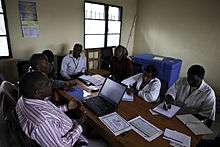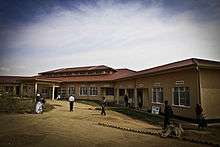Health Builders
 | |
| Founded | 2007 |
|---|---|
| Founders | Josh Ruxin |
| Type | Non-Profit |
| Focus | Health systems strengthening |
Area served | Rwanda |
Key people | Tyler Nelson (Executive Director) |
| Slogan | Health is at the heart of human progress |
| Mission | Health Builders uses business management principles to strengthen health systems and build healthy communities. |
| Website | www.healthbuilders.org |
Health Builders (HB) is a non-profit organization that uses systems-level interventions and infrastructure development to enable comprehensive primary health care for communities that need it. Its mission is to use business management principles to strengthen health systems and build healthy communities.
HB believes that the best way to improve health care is to address the structural challenges that prevent it from operating efficiently. Its goal is to provide health facilities with the management frameworks, strong infrastructure and basic resources to operate efficiently and become sustainable.
HB works with an exit strategy in mind .[1] It helps communities to build their own health systems, providing the knowledge, materials and technical assistance to provide primary care. In doing so, HB aims to not only ensure locally managed health care, but also give local communities an opportunity to prosper.
History
Health Builders' work began in 2007 by Josh Ruxin and was originally under the name Rwanda Works before changing it to Health Builders in 2013. The organization was created on the premise that by applying efficiency-focused business principles to health problems, resources could be maximized, people would be healthier, and poor economies would begin to thrive.[2] In 2015, Mr. Ruxin stepped down and Tyler Nelson was appointed as the new Executive Director of HB [3] .
Since its inception, HB has partnered with the Government of Rwanda and other local partners to improve Rwanda's public health system through hands-on technical assistance, supportive supervision, and management training to public health facilities in need.
In 2008, HB expanded its services to include infrastructural development and technological implementation .[4] HB saw how many public health facilities needed basic facilities like stable walls and roofs, sources of clean water or reliable electricity. It considered these resources critical to health centers' success and, in response, began to provide them alongside its management services.
Today, Health Builders through its partners has fortified primary care services for over 2 million people across Rwanda and provided health care access to 170,000 people formerly without it .[5]
Work
HB’s interventions are divided into three categories: Management, Infrastructure and Technology.
Management

HB’s management work is designed to address the specific constraints faced by each health facility (e.g., limited power supply, staff with limited education and experience, inadequate infrastructure). In partnership with health center staff and local communities, HB develops and implements management models that fit the facility’s needs and overcome specific operational challenges. Once the systems are fully functional, HB withdraws, providing only monthly or quarterly assessments of the programs, and support upon request.
Its eight key domains of management intervention include:
- Human Resources
- Pharmacy Logistics
- Infrastructure
- Data Management
- Financial Management
- Planning and Coordination
- Health Insurance
- Information Technology
Infrastructure

By developing infrastructure, HB seeks to ensure that every community has access to a safe and permanent local health facility that offers a full range of services, including HIV prevention and treatment programs, tuberculosis treatment, family planning, and maternal and child health care. HB fills infrastructure gaps by initiating and overseeing the construction of modern health centers where they do not exist, or where existing facilities are not functional. Once constructed, ownership of the new facility is given to the national government to ensure sustainability.
To date, HB has built five health centers, two maternity wards, and provided solar power to facilities that remain off the grid .[5] A sixth health center is currently under construction in the northwestern district of Nyabihu.
Each new health center serves a catchment population of approximately 25,000 people, though thousands more travel by foot, bike, and bus from other districts to seek the health care those facilities offer .[2]
Technology
By implementing basic technologies in three key categories, HB has improved care delivery and health outcomes for multiple resource-limited communities.
Maternal and Child Health
Many countries continue to struggle with maternal and neonatal mortality, malnutrition, and stunting. HB worked in collaboration with the Rwandan Ministry of Health, UNICEF, and the GE Foundation, to implement RapidSMS ‒ a tool that uses mobile text messaging to track health metrics among pregnant women and children under the age of two ‒ in Rwanda .[6] HB also seeks to improve maternal and child health through its management interventions, targeted approaches to the referral system, and the use of case-based training for healthcare providers.
Safe Water
HB partners with the Center for Global Safe Water at Emory University and the GE Foundation to provide health facilities with high-volume water purification systems. As a result, those facilities can produce purified water for themselves and their surrounding communities. HB currently works with clean water projects in 10 health centers located in the Bugesera and Musanze districts of Rwanda .[7]
Oxygen
Oxygen is a WHO essential drug,[8] noted for reducing infant mortality due to asphyxia, among other life-threatening conditions .[9]
HB has partnered with the GE Foundation and the Government of Rwanda to install a large-scale oxygen plant at one district hospital in Rwanda, complete with a distribution system that would allow the hospital to sell oxygen to surrounding facilities at affordable prices.
CPAP
Continuous Positive Airway Pressure (CPAP) is used on newborns in respiratory distress and helps to improve child survival [10] . HB distributes CPAP equipment, organizes trainings on the device, and engages in monitoring and evaluation of the outcomes and impact of the program.
See also
References
- ↑ Ruxin, Josh (2013). A Thousand Hills to Heaven: Love, Hope, and a Restaurant in Rwanda. ISBN 978-0316232913.
- 1 2 Dhillon, Ranu; Bonds, Matthew; Fraden, Max; Ndahiro, Donald; Ruxin, Josh (2011-07-06). "The impact of reducing financial barriers on utilisation of a primary health care facility in Rwanda". Global Public Health. 7: 71–86. doi:10.1080/17441692.2011.593536. PMC 3227794
 . PMID 21732708.
. PMID 21732708. - ↑ "Tyler Nelson Appointed Executive Director of Health Builders" (PDF). http://healthbuilders.org/. 2015-08-19. External link in
|website=(help) - ↑ "Developing Health Infrastructure - Fact Sheet" (PDF). The Access Project. Retrieved 2015-04-03.
- 1 2 "Developing Health Infrastructure". The Access Project. Retrieved 2015-04-03.
- ↑ "The mobile phone – Rwanda's key weapon in making maternal deaths history". Unicef Stories. 2013-11-13. Retrieved 2015-04-03.
- ↑ Lesser, Grace (2012-06-14). "Press Release - Access Project and General Electric Commission Innovative Water Filtration Systems". The Access Project. Retrieved 2015-04-03.
- ↑ "WHO Model Lists of Essential Medicines". World Health Organization. Retrieved 2015-04-03.
- ↑ "Newborns: reducing mortality". World Health Organization. May 2012. Retrieved 2015-04-03.
- ↑ Vogel, Joshua P; Oladapo, Olufemi T; Manu, Alexander; Gülmezoglu, A Metin; Bahl, Rajiv (2015). "New WHO recommendations to improve the outcomes of perterm birth". The Lancet. 3 (10): e589–e590. doi:10.1016/S2214-109X(15)00183-7.